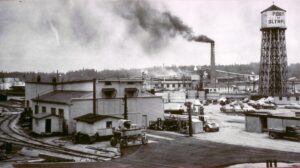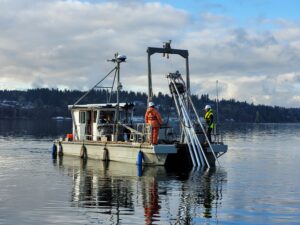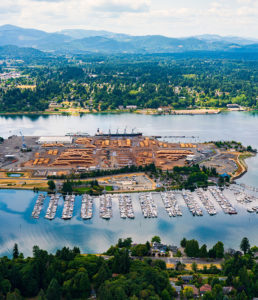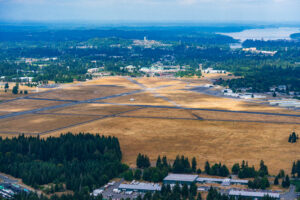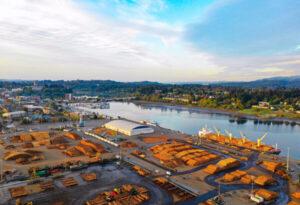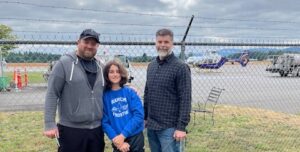Rejuvenating Budd Inlet’s Ecosystem
Unveiling the Hidden Contamination Crisis in Budd Inlet
It’s a Dirty Job:
Sediment Samples are Key to Cleanup
For the first time in over a decade, research crews traversed East Bay to chart sediment contamination below the water’s surface. The long-awaited research effort is a critical step forward to inform the cleanup strategy of Budd Inlet.
During six weeks in January and February, a team of experts collected over 1100 sediment samples from over 100 locations. The team included geologists, engineers, archeologists, and scientists hired by the Port of Olympia. Sediment sampling was conducted under oversight of the Department of Ecology (Ecology) in consultation with local tribes and with permits issued by the City of Olympia and the Army Corp of Engineers. The team was joined by students from The Evergreen State College to observe the process.
Researchers collected both surface-level and deeper sediment. For sampling surface sediments, teams used a grab sampler akin to a clamshell bucket you might see on a crane. Sub-surface samples were yielded through Vibracoring, inserting an aluminum tube able to liquefy sediment and collect sediment as far as 15 feet below the seabed.
Collected sediment samples were preserved in specialized containers to maintain the integrity of the sample until chemical analysis can be performed by accredited laboratories, often providing data in parts per trillion levels.
The chemical analysis, paired with GPS and sediment observational data collected during the sampling process, will make it possible to develop a 3-dimensional map of contamination in the project area. Experts will analyze the location, concentration, and composition of the deposits, providing a stronger understanding of sediment contamination in East Bay.
Sampling, analysis, and sediment mapping are all part of a collaborative effort between the Port of Olympia and local, state, federal government, and tribal partners with a vested interest in the health and future of the inlet. The Port worked closely with Ecology, the US Army Corps of Engineers, and the National Marine Fisheries Service to ensure that sampling activities safeguard marine organisms and avoid sensitive spawning periods for aquatic life.
Looking ahead, depending on funding, the second phase of research is anticipated to begin in late 2024. Researchers will gather sediment samples in West Bay to provide a fuller understanding of Budd Inlet contamination.
Sediment sampling marks an exciting step in the ongoing efforts to clean up and restore Budd Inlet. The Port of Olympia is committed to conducting thorough and effective cleanup operations guided by scientific research and through collaboration with project partners and the community. The Port will continue to move forward in the cleanup process as efficiently as possible while ensuring that the work is done safely, correctly, effectively, and in compliance with the conditions of the Agreed Order between the Port and Ecology.
Want to learn more about the sediment sampling of Budd Inlet? View the FAQs about the research vessel and read the February news release.

